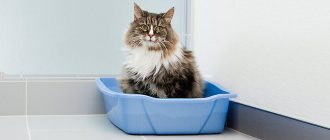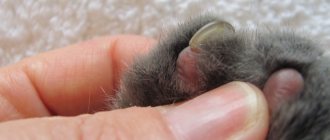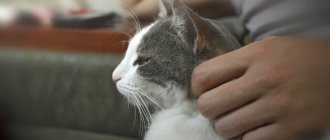If you want to accustom your cat to water, it is recommended to do this from a young age. Animals have developed a persistent dislike for taking water procedures; it is impossible to force a pet to bathe on its own. But there are a number of methods and recommendations for successful bathing. Little kittens can be taught not just to wash themselves in the water, but to fully swim in the bathtub.
Why is a cat afraid to swim?
Fear of water is an instinctive fear. Under natural conditions, wild cats will only get into water if their lives are in serious danger in order to survive. But there is an exception to the rule - tigers. They are considered good swimmers and can catch fish; they can easily withstand water procedures due to their fur; it repels water. Domestic cats generally do not like to bathe; some tolerate it peacefully, while others scratch, meow hysterically, and try to escape. There is an opinion that washing, especially with shampoo, can dry out the delicate skin of pets. Thus, real fear of pets leads to stress and resentment towards the owners.
How can you wash a kitten?
You should not bathe your kitten with regular shampoo intended for human use. This is due to differences in acid-base balance. To avoid injury to the skin and fur of cats, it is best to wash them not with regular shampoo, but with a shampoo specially designed for cats.
If the cat is a little dirty, then there is no need to bathe it completely; you can simply clean the dirty area with wet wipes.
The most common types of shampoos
Modern veterinary medicine is able to offer different types of detergents that help to properly bathe a kitten:
If you wash your baby with liquid shampoo, you can get a soft and silky coat. This product can be used from any age
It is necessary to apply a small amount of shampoo, it is important to remember that it tends to foam, otherwise it will then become problematic to completely wash it off from the animal’s fur. If your pet has a panicky fear of water, then washing with dry shampoo will be a salvation. It is applied to the cat’s skin and after a while it is easily combed off the animal’s fur along with the dirt.
This detergent can be used quite often, as it does not dry out the skin and does not upset the pet’s fat balance. Not recommended for use under 3 months. Make sure your cat's skin is completely dry before applying. The spray shampoo can also be used as a dry shampoo; it should not be applied to the pet’s wet coat. Since this product has a strong odor, it is not recommended for use on animals under 6 months of age.
You should not buy shampoos for adult animals and use them on kittens, since the latter have more delicate skin and are at risk of getting dermatitis.
It is best to accustom your cat to washing from an earlier time, using special detergents. Taking a bath should be carried out in a good mood not only for the owner, but also for the pet, so that there is no stress associated with this event in the future. The reward for correct behavior in the bathroom can be a treat, and this method will help reinforce positive emotions in the animal.
Why wash?
Cat breeders with extensive experience clearly believe that pets need to be bathed in the following cases:
- in the presence of parasites, fleas, ticks in the coat;
- if serious contamination appears;
- as a means of prevention;
- during molting.
During coat changes, water treatments are required.
Cats shed periodically. When an animal licks its own fur, dirt and germs enter the body with saliva. During the molting period, the amount of fur increases and it is difficult for the pet to cope with its natural shedding. Thus, the digestive system of the pet is the first to suffer. To avoid this problem, it is recommended to combine the molting period with bathing the cat.
What should you not do while swimming?
As you can imagine, bathing a cat, a procedure that takes only a few minutes, is quite difficult for both the animal and its owner. Therefore, it is necessary to minimize possible irritants:
- Do not open the tap at full capacity.
- The shower should not be turned on at full power.
- Do not use dog shampoo or dishwashing detergent to wash your pets.
- There is no need to pour shampoo from the bottle directly onto the coat, especially dry hair.
- It is strictly forbidden to stuff the animal's ears with cotton - it can cause serious irritation.
After bathing your cat, you need to dry it thoroughly with a towel, since cats get very cold after such a water procedure, especially if the apartment is not very warm. Many owners consider it lucky if the cat allows him to be warmed in a towel for at least five to ten minutes. Then the animal will most likely break free and begin to lick its coat on its own.
Pre-cover all surfaces where your pet can sit down to lick with towels. They will absorb moisture, and your sofas and carpets will remain stain-free. If your cat continues to tremble violently within five minutes, try to dry it with a hairdryer to avoid catching a cold or even pneumonia.
You already know how to bathe a cat. Now it’s worth talking about combing the fur. When the cat stops licking his fur, pick him up and brush him with a wide-toothed brush. After bathing, the coat becomes very brittle, so combing must be extremely careful.
Rules for accepting water procedures
- If possible, you should accustom your kitten to water from a young age, bathing it once a month. Thus, in adulthood it is easier to achieve humility during the procedure.
- Cats have a higher body temperature than humans, for this reason it is imperative to strictly observe a comfortable temperature regime of 38-39 degrees.
- If the owner is lucky and the animal likes bathing, then by filling the bath with water you can give it time to swim and play with its favorite toys.
- In order for water procedures to become a habit, it is recommended to regularly and consistently follow all the rules and recommendations for training.
- After washing, you should not let the kitten go outside for 24 hours to avoid drafts.
- It is recommended to use special bathing products; there are liquid and dry shampoos.
- Make sure that the cat does not lick the fur until all the foam is washed off from the fur.
- You need to prepare several towels.
- You should not make loud noises, scream, or cause pain to your pet, otherwise stress cannot be avoided.
- The shampoo should not get into the eyes and ears, because it causes burning and irritation, which will discourage the pet from bathing for a long time.
For hygiene procedures, only specialized cleaning products are used.
For swimming you will need the following items:
- 2 containers with water;
- thermometer for measuring water temperature;
- rags;
- several towels;
- toys;
- special shampoos - liquid or dry;
- air conditioning (if necessary);
- comb-brush;
- sponge or small ladle;
- gloves for hands;
- robe or overalls.
When to bathe a cat
Felines are neat and tidy, quite capable of independently taking care of the cleanliness of their “fur coat.” Mustache-striped cats wash and lick themselves after sleeping, eating and going to the toilet, and also thoroughly clean their paw pads and claws after running along the street. But sometimes circumstances are such that a furry pet needs a bath or a cleansing wash. An urgent reason for bathing may be:
- Postpartum period. Mothering cats try to clean up after themselves and their babies in the nest, but if the mother is not feeling well or the litter is too large and watery, amniotic fluid can soak the fur on the back of the body. The problem is contributed to by the animal's long coat and the presence of tangles. When the amniotic fluid dries, it sticks together the fur, and the rapidly developing microflora gives off an unpleasant odor. Felinologists recommend not to disturb the mother in labor for the first time and, if possible, wipe her right in the nest using wet wipes and a small towel. And only 10-14 days after the babies are born, the female can be bathed and combed.
- Contamination of wool during walking. A cat walking on its own usually chooses more or less dry and clean places, avoiding deep puddles and sticky soil. However, hunting and sexual instincts can be carried to places where the sanitary situation is far from ideal. Carried away by tracking and catching prey, the cat can get quite dirty, and a fight with a rival for territory can end with two interlocking bodies rolling on the ground. Sometimes a cat accidentally gets smeared with machine oil, paint or other substances that require urgent removal from the surface of the fur.
- Disease of the skin and fur. Eczema and dermatitis require bathing as a therapeutic measure. In this case, use special shampoos recommended by a veterinarian. To alleviate the pet’s condition, a set of procedures is required, repeated every 5-7 days.
- Damage by ectoparasites. Fleas, lice-eaters, and ear mites that parasitize cats cause brittleness and hair loss, severe itching, scratching, redness and bald spots. The animals become nervous, constantly itching, licking themselves and picking at the hairs with their teeth. To kill parasites, use special antiparasitic shampoos, sold in pet stores and veterinary pharmacies.
- For cooling purposes during hot periods. Cats are unable to cool themselves like humans due to the lack of sweat glands. An analogue of sweating is frequent licking and wetting of fur with saliva, which evaporates at elevated environmental temperatures. Washing with clean water with a temperature of about +36°C will help the thermoregulatory system of the mustachioed tabby and prevent overheating.
How to teach bathing?
To teach a kitten to take water procedures, take 2 containers, one is completely filled with water, the other 5 centimeters. The temperature should be comfortable for the animal, 38-39 degrees. It is recommended to wear latex or rubber gloves and additional clothing in case the cat scratches. Place cloths or cloths on the bathroom floor to prevent slipping when water splashes. If the kitten starts to get nervous, you should calm it down, pick it up and stroke it. Carefully place the cat in a bowl with less water and slowly water the pet, starting from the back and lastly moving to the neck; there is no need to wash the ears and face.
To calm your cat, you can put your favorite toys in the bathtub. Afterwards, if necessary, apply a special shampoo and comb the coat with a comb. Then you need to thoroughly rinse the foam from the coat. If the kitten breaks out, it is recommended to hold it gently by the paws or withers, without screaming, rough movements and without using force. At the end of bathing, it is recommended to blot the pet with a soft terry towel and hold it in your hands for 10-15 minutes. The bathing procedure should be repeated once a month or when it is heavily soiled, because water can wash away the protective fat layer.
You should not tie your pet during the washing period. During panic attacks, a cat can harm itself with a collar or leash.
When holding an animal in the bathtub, use a firm grip. It is correct to grab the cat by the fold on the withers and avoid areas near the belly. So, the pet is able to instinctively attack with its hind legs. If he is overcome by panic and fear, it is recommended to wrap the kitten in a towel and leave the bathroom. If there is foam on the fur, remove it with a damp cloth and comb the animal.
Minimizing stress when bathing
In order not to traumatize the cat’s psyche too much, the owner should remember the set of rules “Cats on the Water”, ignoring which will turn bathing into a fierce struggle, and the bathroom into a battlefield.
So, for security reasons, it is strongly not recommended:
- Lower the cat into a bathtub or container (basin) already filled with water. Sensing the approach of a large volume of liquid, the animal will turn on its protective instinct and do everything to escape and avoid drowning.
- Putting a choke collar on a cat or tying it with a leash in order to forcefully achieve obedience. Fetters will only increase fear, cause pain and even more intensify the desire to leave the terrible place.
- Water an untrained cat with water from a flexible hose. Murki instinctively avoid water jets falling on themselves, and therefore always hide from the rain. Excessive dousing in the bathroom will also not bring them pleasure.
- Use too cold or too hot water. The skin of cats is very sensitive, so the temperature of the bathing water should be pleasant and not cause discomfort. Usually the water is heated to +38.5-39°C, but on a hot day it can be a little cooler.
- Bathe your cat in low light. It has been proven that in bright light the animal becomes more submissive and is more likely to agree to water “execution”.
- why cats are afraid of water;
- how to wash a cat;
- Is it possible to bathe a cat after giving birth?
This is interesting: What to do when a cat scratches its ear until it bleeds
Cat breeds that are loyal to water
Yes, the relationship with water in domestic cats depends on how the first bathing experience goes, as well as on the character of the pet itself. The more curious and fearless the kitten, the more likely he is to enjoy the water element. Conventionally, we can distinguish the following breeds, whose representatives are more loyal to water procedures than others.
Table 1. Cat breeds that love water
| Breed | Characteristics |
| These hairless cats occupy the first place in the ranking of cat breeds that show an interest in water. This may be due to the lack of hair and the fact that Sphynx cats dry very quickly after bathing, and therefore do not experience discomfort. The only thing the owner needs to monitor is the temperature of the water so that the hot cat does not catch a cold or get sick. | |
| Bobtails have a high level of intelligence and are also very attached to their owner, so they follow him even to the bathroom. If the cat considers that the water does not pose a danger to it, it will be happy to accompany the owner during water procedures. | |
| Active and funny Abyssins, for the most part, are not at all afraid of getting wet. These are very mischievous cats, ready for energetic and active games in any form, so a representative of the Abyssinian breed will not be embarrassed by water splashes, which are so exciting to catch. | |
| Large and brave, these cats often accompanied sailors in the past, and nowadays they are loyal to the water. It’s not for nothing that Maine Coons are called “dog-cats,” and when it comes to bathing, representatives of this breed are more like dogs who love to frolic in the water. But, if a Maine Coon is afraid of water procedures, he will resist like a wild animal, so it is important to accustom the kitten to bathing as early as possible. | |
| Gentle and good-natured Devons, like sphinxes, have a very modest fur coat and dry quickly after water treatments. In addition, these cats are playful and good-natured, so it is enough to invite the Devon Rex to play in the bath for the pet to become interested in new entertainment. | |
| Energetic savannahs were bred by crossing domestic cats with wild ones, perhaps it was from this inbreeding that they developed a love for water. Many savannah owners note that these cats are not at all afraid of moisture, but on the contrary, they look for every opportunity to frolic in the water or play with water splashes. Savannahs kept in country houses sometimes even voluntarily swim in pools or outdoor fountains. | |
| By nature, Bengals are similar to Savannahs, and they have the same love for water. Spotted beauties happily cool off in the sink on a hot day, often ignore a bowl of water, preferring to drink running water from the tap, and also play in a filled bathtub or even basin. | |
| These strong, large cats are not afraid of water, like their wild relatives. The stern Norwegian is quite ready to walk in the rain or heavy snow, and will also swim in a filled bathtub and even “hunt” for toys if the owner offers him such entertainment. | |
| According to legend, a representative of this breed left Noah's Ark to swim to the Turkish shores. But the country greeted the cat with such unbearable heat that she plunged into the cold Lake Van, from where she got her name. Modern representatives of the breed fully correspond to the legend, and are extremely loyal to water in all its forms. | |
| These are cats with a very flexible nervous system, adaptable and curious, and this also applies to water procedures. The Egyptian Mau enjoys taking baths, playing with water streams and splashes, and even swims in artificial reservoirs without problems, if it has access to them. | |
| Independent Siamese cats are also lovers of water treatments. Owners note that cats jump into the bathtub or walk into the shower without fear, try to catch toys in the silt of a filled bucket, and do not run away from the irrigation system in the garden. |











